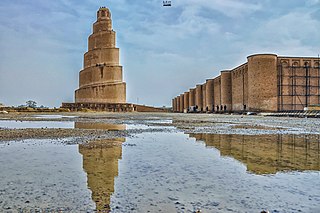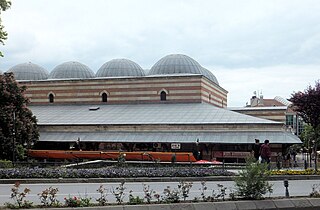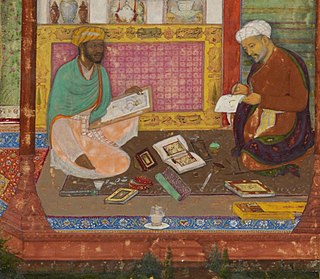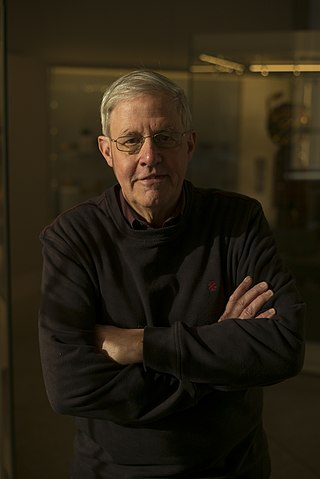Related Research Articles

Hatra was an ancient city in Upper Mesopotamia located in present-day eastern Nineveh Governorate in northern Iraq. The ruins of the city lie 290 km (180 mi) northwest of Baghdad and 110 km (68 mi) southwest of Mosul. It is considered the richest archaeological site from the Parthian Empire known to date.

Samarra is a city in Iraq. It stands on the east bank of the Tigris in the Saladin Governorate, 125 kilometers (78 mi) north of Baghdad. The modern city of Samarra was founded in 836 by the Abbasid caliph al-Mu'tasim as a new administrative capital and military base. In 2003 the city had an estimated population of 348,700. During the Iraqi Civil War (2006-08), Samarra was in the "Sunni Triangle" of resistance.

A bedesten is a type of covered market or market hall which was historically found in the cities of the Ottoman Empire. It was typically the central building of the commercial district of an Ottoman town or city, where the most important and precious goods were kept and sold. Its function was comparable or equivalent to that of a qaysariyya in other regions, though the architecture of the latter could be different and be similar to that of a bazaar with its own streets.

The Great Mosque of Samarra is a mosque from the 9th century CE located in Samarra, Iraq. The mosque was commissioned in 848 and completed in 851 by the Abbasid caliph Al-Mutawakkil who reigned from 847 until 861. At the time of construction, it was the world's largest mosque. It is known for its 52 metres (171 ft) high minaret encircled by a spiral ramp. The mosque is located within the 15,058-hectare (37,210-acre) Samarra Archaeological City UNESCO World Heritage Site, listed in 2007.
Malik ibn Nuwayra, was the chief of the Banu Yarbu, a clan of the Banu Hanzala, which was a large section of the powerful tribe of Bani Tamim.

An iwan is a rectangular hall or space, usually vaulted, walled on three sides, with one end entirely open. The formal gateway to the iwan is called pishtaq, a Persian term for a portal projecting from the facade of a building, usually decorated with calligraphy bands, glazed tilework, and geometric designs. Since the definition allows for some interpretation, the overall forms and characteristics can vary greatly in terms of scale, material, or decoration.

Jumeirah Mosque is a mosque in Dubai, Emirate of Dubai, United Arab Emirates. Construction began in 1975 and the mosque opened in 1979; the mosque is built in a combination of historical Islamic architectural styles, including Fatimid and Mamluk. It was a gift from the late Sheikh Rashid bin Saeed Al Maktoum, the former Ruler of Dubai to his son and heir, the Sheikh Mohammed bin Rashid Al Maktoum.

Qasr al-Hayr al-Sharqi is a castle (qasr) in the middle of the Syrian Desert. It was built by the Umayyad caliph Hisham ibn Abd al-Malik in 728-29 CE in an area rich in desert fauna. It was apparently used as a military and hunting outpost. The palace is the counterpart of Qasr al-Hayr al-Gharbi, a nearby castle palace built one year earlier. It is one of the so-called desert castles.

The horseshoe arch, also called the Moorish arch and the keyhole arch, is a type of arch in which the circular curve is continued below the horizontal line of its diameter, so that the opening at the bottom of the arch is narrower than the arch's full span. Evidence for the earliest uses of this form are found in Late Antique and Sasanian architecture, and it was then used in Spain by the Visigoths. But in the 19th century, perhaps when these earlier uses had not been realized, it became emblematic of Islamic architecture, especially Moorish architecture and Mozarabic art in Iberia. It also made later appearances in Moorish Revival and Art Nouveau styles. Horseshoe arches can take rounded, pointed or lobed form.

The Sultanate of Ahmednagar was a late medieval Indian Marathi kingdom located in the northwestern Deccan, between the sultanates of Gujarat and Bijapur, ruled by the Nizam Shahi dynasty. It was established when Malik Ahmed, the Bahmani governor of Junnar, after defeating the Bahmani army led by general Jhangir Khan on 28 May 1490, declared independence and established the Ahmadnagar Sultanate.
Qasr Tuba is an 8th-century Umayyad qasr or castle in the Amman Governorate of northern Jordan.

The illuminated manuscript Khamsa of Nizami British Library, Or. 12208 is a lavishly illustrated manuscript of the Khamsa or "five poems" of Nizami Ganjavi, a 12th-century Persian poet, which was created for the Mughal Emperor Akbar in the early 1590s by a number of artists and a single scribe working at the Mughal court, very probably in Akbar's new capital of Lahore in North India, now in Pakistan. Apart from the fine calligraphy of the Persian text, the manuscript is celebrated for over forty Mughal miniatures of the highest quality throughout the text; five of these are detached from the main manuscript and are in the Walters Art Museum, Baltimore as Walters Art Museum MS W.613. The manuscript has been described as "one of the finest examples of the Indo-Muslim arts of the book", and "one of the most perfect of the de luxe type of manuscripts made for Akbar".

The Maison de l'Orient et de la Méditerranée is a research body in Lyon, France, that specialises in the Mediterranean and the Middle East and the first steps of humanity. It is dedicated to its founder, historian Jean Pouilloux.
Holly Pittman is a Near Eastern art historian and archaeologist, and an expert in Near Eastern glyptic art. She is the Bok Family Professor in the Humanities and a Professor in the History of Art Department of the University of Pennsylvania and serves as a curator in the Near East Section of the University of Pennsylvania Museum of Archaeology and Anthropology. Before joining the University of Pennsylvania, she was a curator of Ancient Near Eastern Art at the Metropolitan Museum of Art from 1974 to 1989. Since 1972, she has conducted archaeological excavations throughout the Middle East, including projects in Syria, Turkey, Cyprus, Iran, and Iraq. In 2019 she began directing new excavations at the site of Lagash in southern Iraq.
Pushkar Sohoni is an architect, and an architectural and cultural historian. He is an associate professor in the department of Humanities and Social Sciences at the Indian Institute of Science Education and Research, Pune. He was Chair of the department from 2019 to 2024.

Richard L. Zettler is an American archaeologist of Early Bronze-Age Mesopotamia, with special interests in urban development and the organization of complex societies. At the University of Pennsylvania, he is a professor in the Department of Near Eastern Languages and Civilizations at the University of Pennsylvania and serves as Associate Curator-in-Charge of the Penn Museum’s Near East section. Working in partnership with colleagues from the University of Mosul and with Iraq’s State Board of Antiquities and Heritage, Zettler secured a three-year grant from the U.S. State Department in 2018 to identify and where possible to restore historic structures damaged by the Islamic State (ISIS) fighters who held Mosul from 2014 to 2017. This project has since expanded into the Mosul Heritage Stabilization Program (MHSP), which has also received funds from the Swiss foundation known as the International Alliance for the Protection of Heritage in Conflict Areas (ALIPH).

Muhammad Daulat was a leading artist in Mughal painting, active on imperial commissions between about 1595 and 1635–1640, during the reigns of Akbar, Jahangir, and Shah Jahan. He began his career painting large narrative scenes, then specialized in portraits, but later in his career seems to have specialized in highly ornate borders to miniatures.

Mina'i ware is a type of Persian pottery, or Islamic pottery, developed in Kashan in the decades leading up to the Mongol invasion of Persia and Mesopotamia in 1219, after which production ceased. It has been described as "probably the most luxurious of all types of ceramic ware produced in the eastern Islamic lands during the medieval period". The ceramic body of white-ish fritware or stonepaste is fully decorated with detailed paintings using several colours, usually including figures.

Abu'l-Fath Pir Budaq more commonly known simply as Pir Budaq, son of Jahān Shāh of the Qara Qoyunlu dynasty, was governor of Shiraz (1456–1460) and of Baghdad (1460–66) where he introduced a period of political and economic stability. He is noted for developing a library of the finest manuscripts, for his patronage of the arts, for establishing Baghdad as an important centre of the arts and for reinvigorating the art of the book. He has been described as the greatest Turkmen patron of the arts.
References
- ↑ "Renata Holod | Penn History of Art". www.sas.upenn.edu. University of Pennsylvania. Retrieved 2 March 2017.
- ↑ Roxburgh, David J. (2014-11-14). Envisioning Islamic Art and Architecture: Essays in Honor of Renata Holod. BRILL. ISBN 9789004280281.
- ↑ Roxburgh, David J. (2014-11-14). Envisioning Islamic Art and Architecture: Essays in Honor of Renata Holod. BRILL. ISBN 9789004280281.
- ↑ "Rasem Badran | [eng] State mosque competition, Baghdad, Iraq | Archnet". archnet.org. Retrieved 2017-04-30.
- ↑ "Islamic Cultural Center of New York". SOM. Retrieved 2017-04-30.
- ↑ "Islamic Cultural Center of New York | | Archnet". archnet.org. Retrieved 2017-04-30.
- ↑ "Palm Jumeirah Gateway Bridge (Dubai, 2006) | Structurae". Structurae. Retrieved 2017-04-30.
- ↑ Haddad, Yvonne Yazbeck; Smith, Jane I. (2014-01-01). The Oxford Handbook of American Islam. Oxford University Press. ISBN 9780199862634.
- ↑ "home | Archaeologists & Travelers In Ottoman Lands". www.ottomanlands.com. Retrieved 2017-04-29.
- ↑ "Osman Hamdi Bey and the Americans". www.peramuseum.org. Retrieved 2017-04-29.
- ↑ "► Muqarnas § Aga Khan Program for Islamic Architecture". agakhan.fas.harvard.edu. Retrieved 2017-04-29.
- ↑ Administrator. "Scientific Committee". www.maxvanberchem.org. Retrieved 2017-04-29.
- ↑ "Intellect Ltd". www.intellectbooks.co.uk. Retrieved 2017-04-29.
- ↑ "EFEO - Publications - Arts Asiatiques". www.efeo.fr. Retrieved 2017-04-29.
- ↑ Administrator. "Holod, Renata, Ph.D." www.kolbsociety.com. Retrieved 2017-04-30.
- ↑ "Envisioning Islamic Art and Architecture | Brill". www.brill.com. Retrieved 2017-04-30.
- ↑ "Ukrainian Museum - Welcome, About, Trustees, volunteer, intern, opportunities". www.ukrainianmuseum.org. Retrieved 2017-04-29.